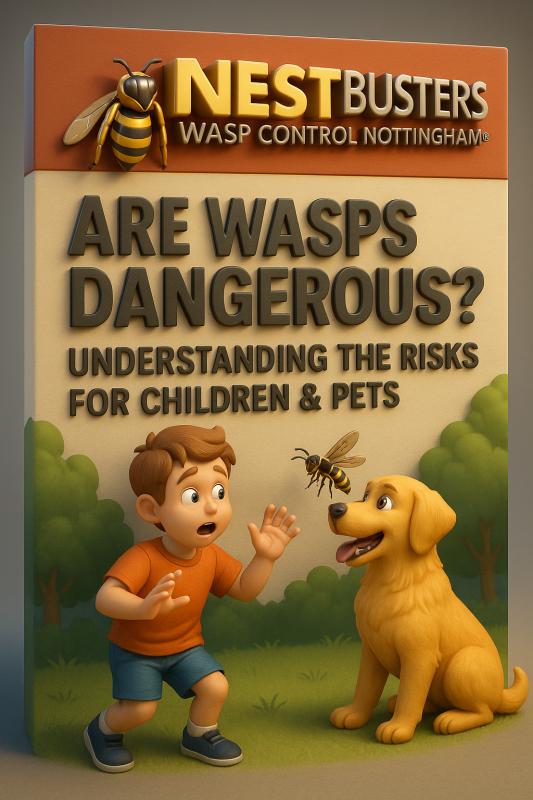Are Wasps Dangerous? What UK Parents & Pet Owners Should Know
As summer approaches, many of us love spending time outside — in gardens, parks, or even at BBQs. But for parents and pet owners in the UK, wasps can be a real concern. They tend to become more aggressive during the warmer months, and their stings can be particularly harmful to kids and animals.
Don’t underestimate the risks. While most wasp stings are just painful, for some people — especially children and those with allergies — they can cause severe reactions like anaphylaxis. Knowing how wasps behave and taking a few simple steps can help you stay safe.

Key Takeaways
- Wasps are more aggressive during summer.
- Their stings can cause serious allergic reactions.
- Children and pets are especially vulnerable.
- Prevention and early action are the best defense.
Understanding Wasps in the UK
Common Wasp Species
The most common wasps in Britain are the German wasp (Vespula germanica) and the Common wasp (Vespula vulgaris). They build nests and often show up in gardens, sheds, and parks — especially during summer.
Wasp Behaviour by Season
Wasps are most active in spring and summer when they’re building nests and foraging. In late summer, they become more aggressive due to food shortages. By autumn, their colonies begin to die out.
Why Wasps Sting — and Why It Matters
Wasps Can Sting More Than Once
Unlike bees, wasps can sting multiple times. Their smooth stingers don’t get stuck, which makes them more dangerous during an attack — especially if provoked or protecting a nest.
Wasp vs. Bee Sting
Wasp venom differs from bee venom and can cause different reactions. Wasp stings tend to be more painful and may trigger stronger allergic responses.
Defensive Nature
Wasps are territorial. If they sense danger near their nest, they may swarm and attack. They even release pheromones to alert other wasps — making the threat worse.
Why Children Are at Higher Risk
Physical Vulnerability
Children are smaller and have more sensitive skin, which means the same amount of venom affects them more severely.
| Factor | Impact on Children |
|---|---|
| Smaller Body | Greater venom impact |
| Sensitive Skin | More swelling & redness |
Behavioural Risks
Kids are naturally curious and may swat at wasps or go near nests without realising the danger.
Serious Reactions in Kids: What to Watch For
Normal vs. Allergic
- Normal Reaction: Pain, redness, minor swelling
- Allergic Reaction: Hives, breathing difficulty, swelling in other areas
Signs of Anaphylaxis (Medical Emergency)
- Difficulty breathing
- Swelling of lips, tongue, or throat
- Rapid heartbeat
- Feeling faint
Always call emergency services if these symptoms appear. If prescribed, use an EpiPen immediately.
Curious Pets and Wasp Risks
Why Pets Get Stung
Dogs and cats often chase or bite flying insects. If they catch a wasp, it may sting their mouth, nose, or eyes.
Common Sting Scenarios for Pets
| Pet Behaviour | Risk Level | Prevention Tips |
| Sniffing nests | High | Keep pets away from known nests |
| Chasing wasps | Medium | Supervise outdoor time |
| Swatting at wasps | High | Train pets to avoid insects |
Symptoms in Pets
- Swelling
- Drooling or vomiting
- Trouble breathing
Seek a vet’s help if symptoms seem serious or worsen quickly.
Wasp Nests Near the Home
Where Nests Hide
Wasp nests may be found:
- In eaves and attics
- Behind wall cavities
- In sheds or garages
- Under decking
Why Nests Increase Risk
Having a nest nearby makes wasp encounters more likely. Even small movements near a nest can trigger a swarm.
| Risk Factor | Danger Without Nest | Danger With Nest |
| Kids outdoors | Low | High |
| Pets nearby | Moderate | Very High |
| Gardening | Moderate | High |
Prevention Tips
For Kids
- Teach them not to provoke or touch wasps
- Dress them in light, neutral colours
- Avoid sugary drinks/snacks outdoors
For Pets
- Supervise outdoor play
- Don’t let pets sniff around bushes or sheds
- Watch closely in late summer
Around the House
- Keep bins sealed
- Don’t leave food outside
- Use wasp traps or repellents
- Check for nests regularly
Professional Wasp Nest Removal
Why DIY Can Be Risky
Removing nests without the right gear can lead to stings or incomplete removal. Wasps may return if the job isn’t done properly.
| Risk | Consequence |
| DIY Removal | Swarming, repeat infestations, injury |
| Property Damage | Holes in walls/ceilings |
What a Professional Does
- Full inspection
- Safe nest removal
- Tips to prevent future infestations
Hiring a pest control service like Netbusters ensures safety and peace of mind.
Final Thoughts
Wasps are more than just annoying — they can pose real dangers, especially for children and pets. But with the right knowledge, you can enjoy the outdoors safely.
- Learn their habits
- Take steps to prevent nests
- Know how to react to stings
If there’s a nest nearby, don’t risk it — contact a local pest expert like Netbusters for safe and fast removal.
FAQ
Are wasps more aggressive in certain parts of the UK?
No. Aggression depends more on the season and whether a nest is nearby than location.
What are signs of an allergic reaction in kids?
Swelling of the face or throat, breathing difficulty, fast heartbeat — seek help fast.
How do I treat a wasp sting at home?
Clean with soap and water, apply a cold compress, use antihistamine if needed.
Should I remove a nest myself?
It’s risky. Call a professional for safe removal.
Can pets have severe reactions to wasp stings?
Yes — especially if stung near the face or multiple times. Contact your vet quickly.
How do I prevent wasps around my home?
Seal cracks, cover bins, remove food sources, and check for nests often.

